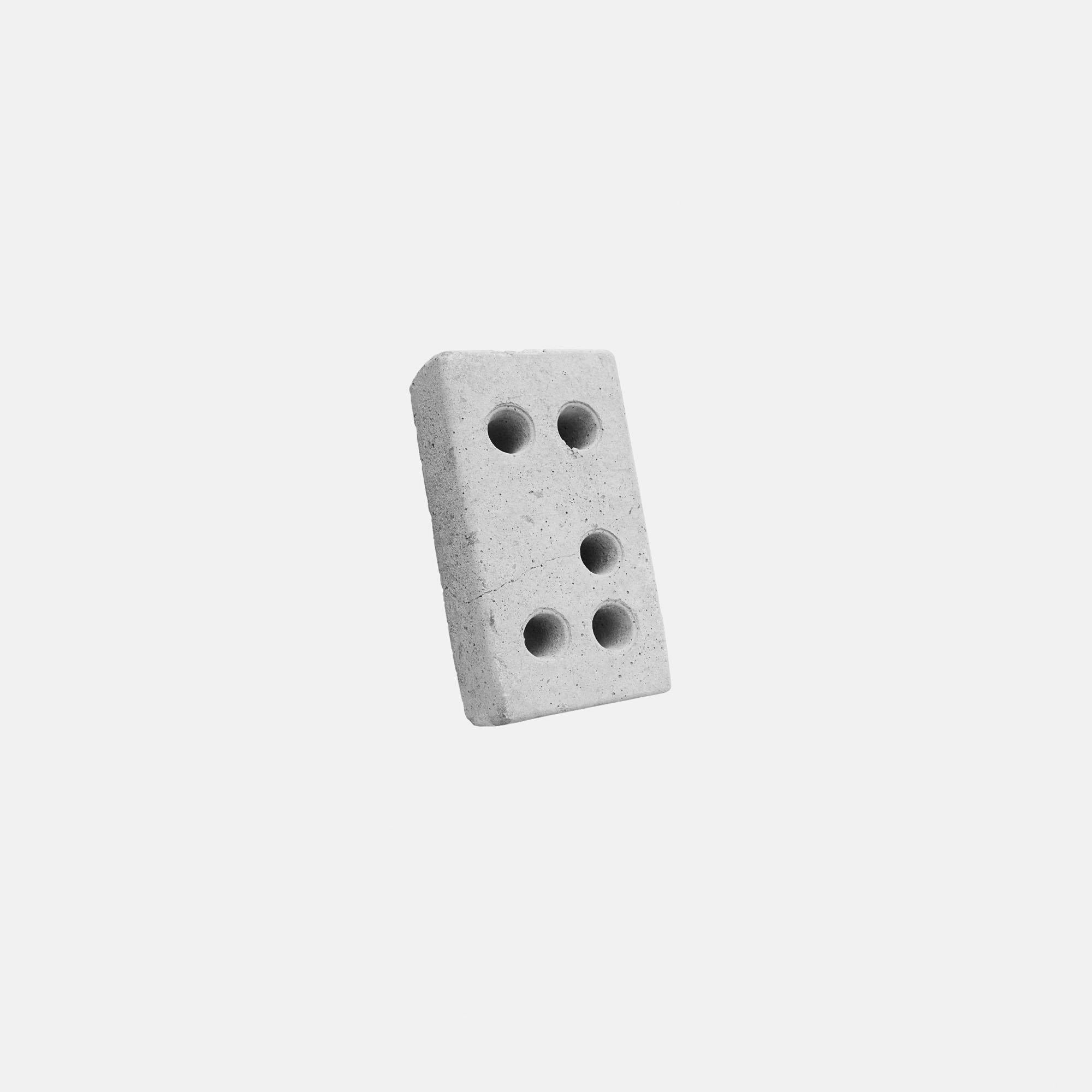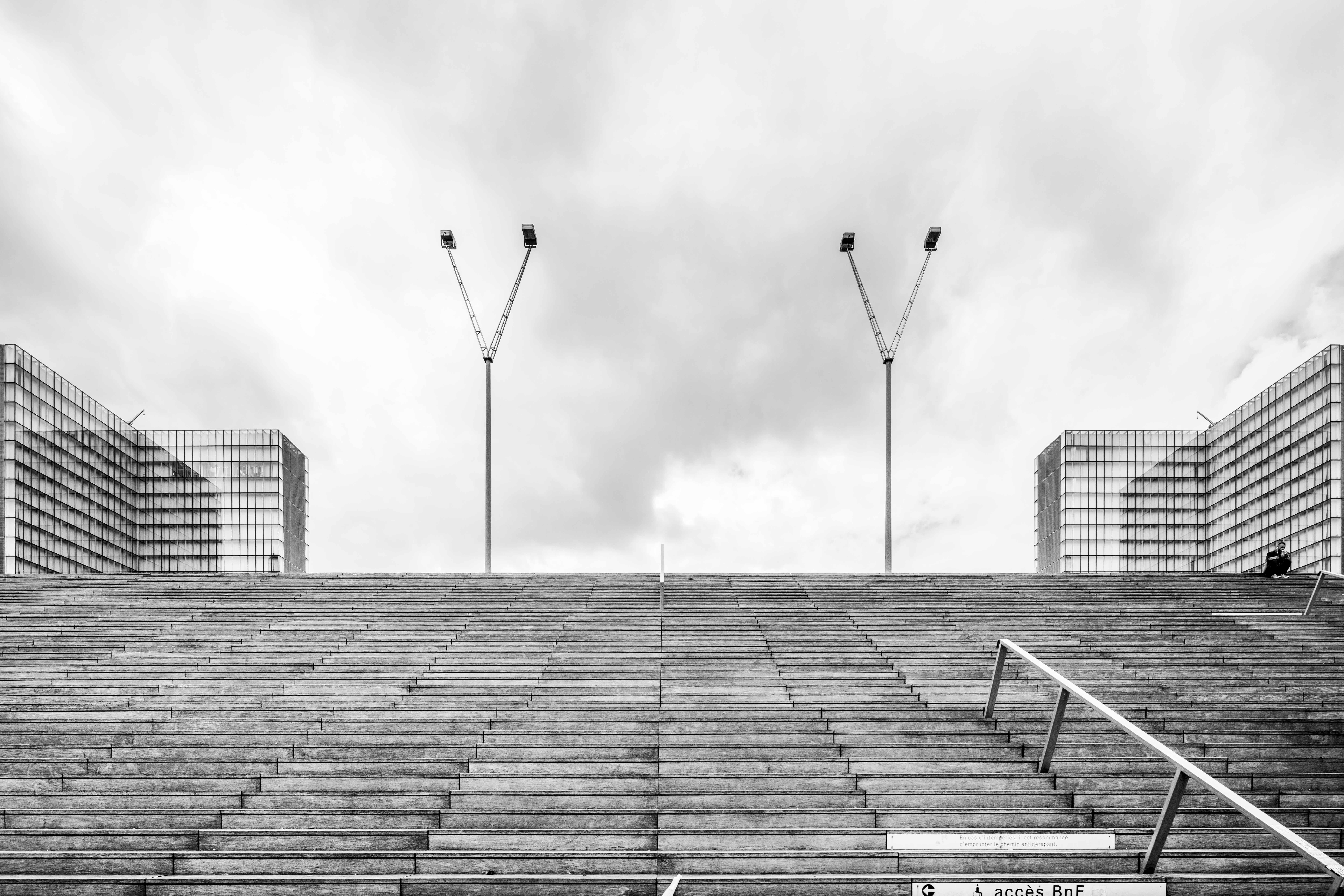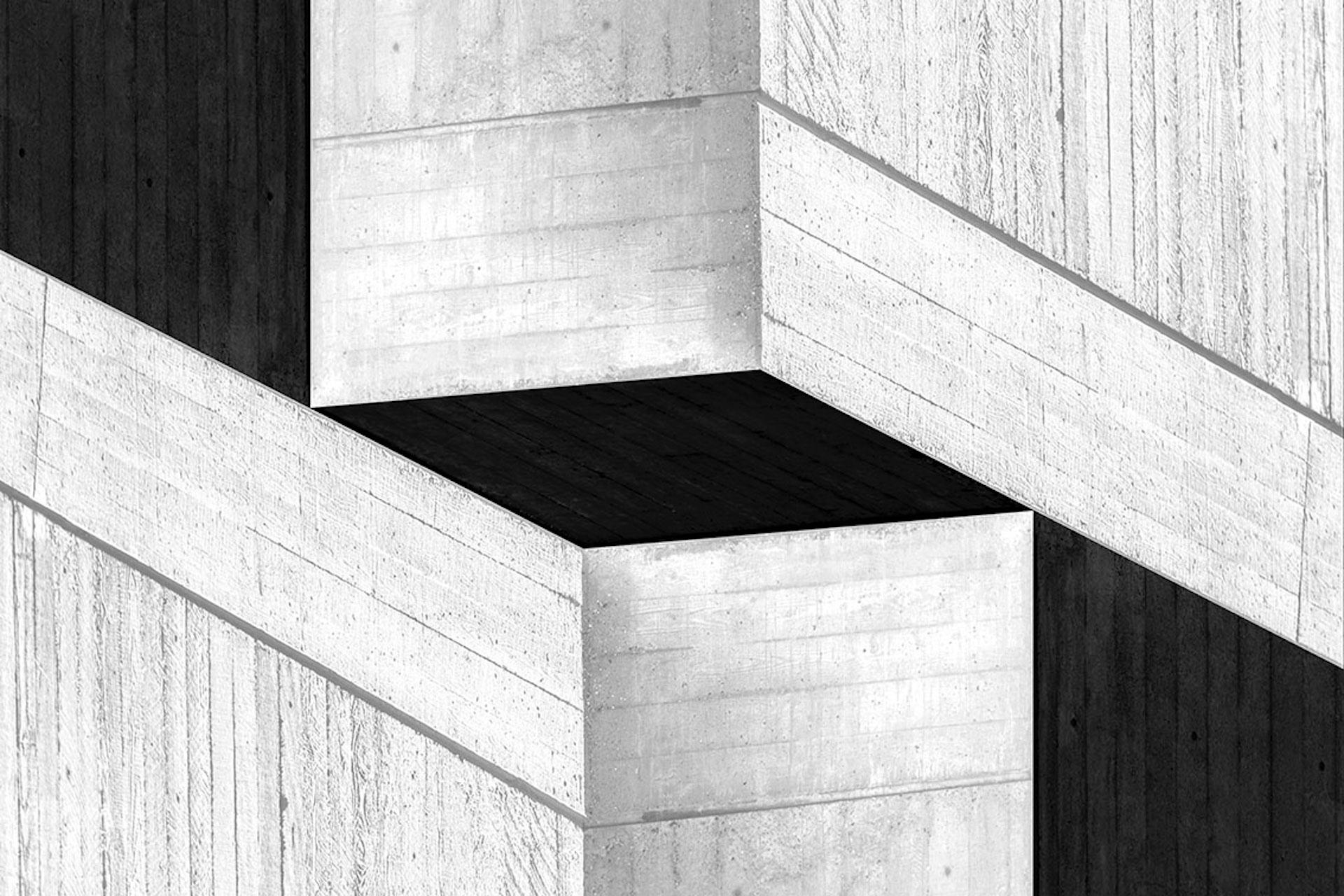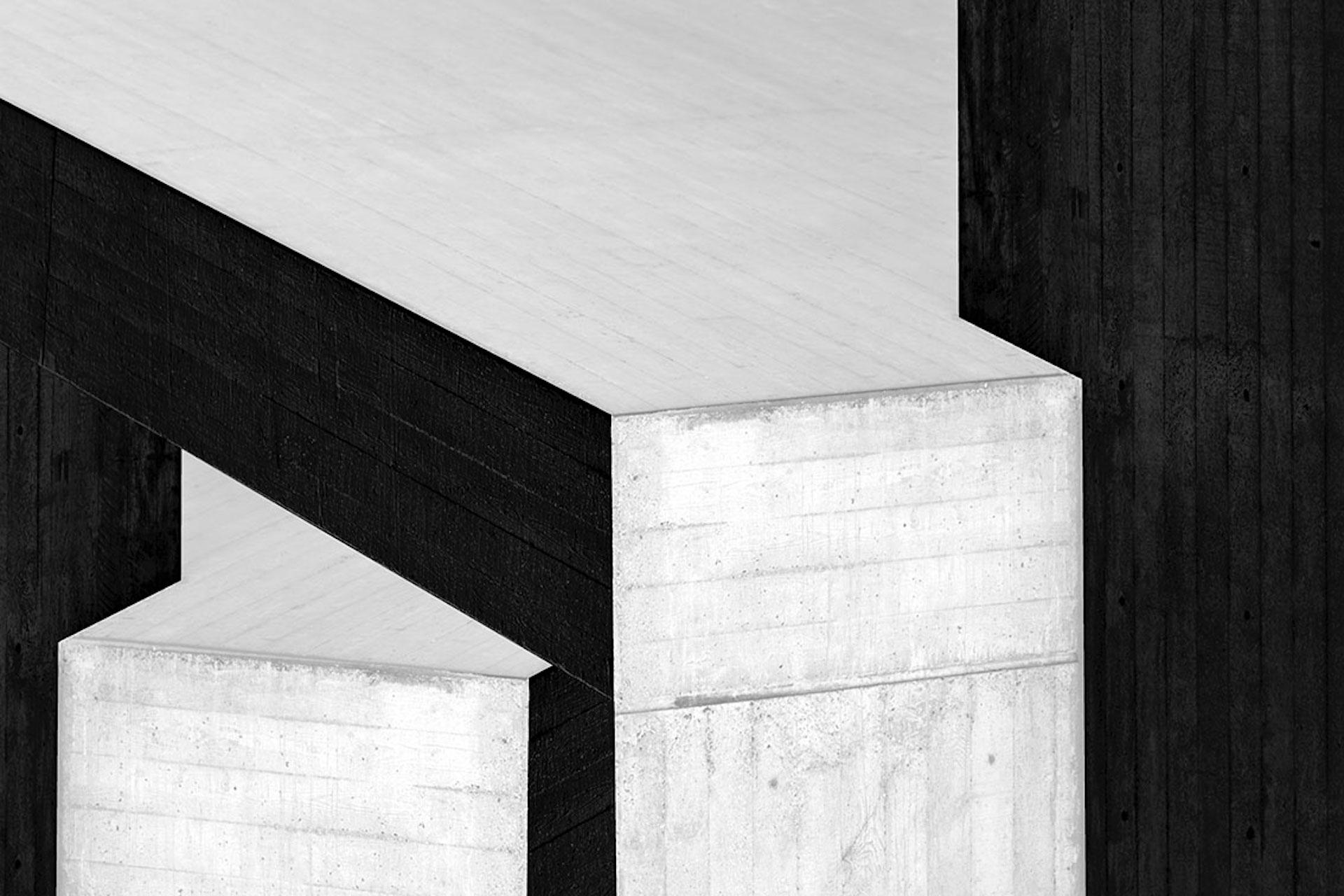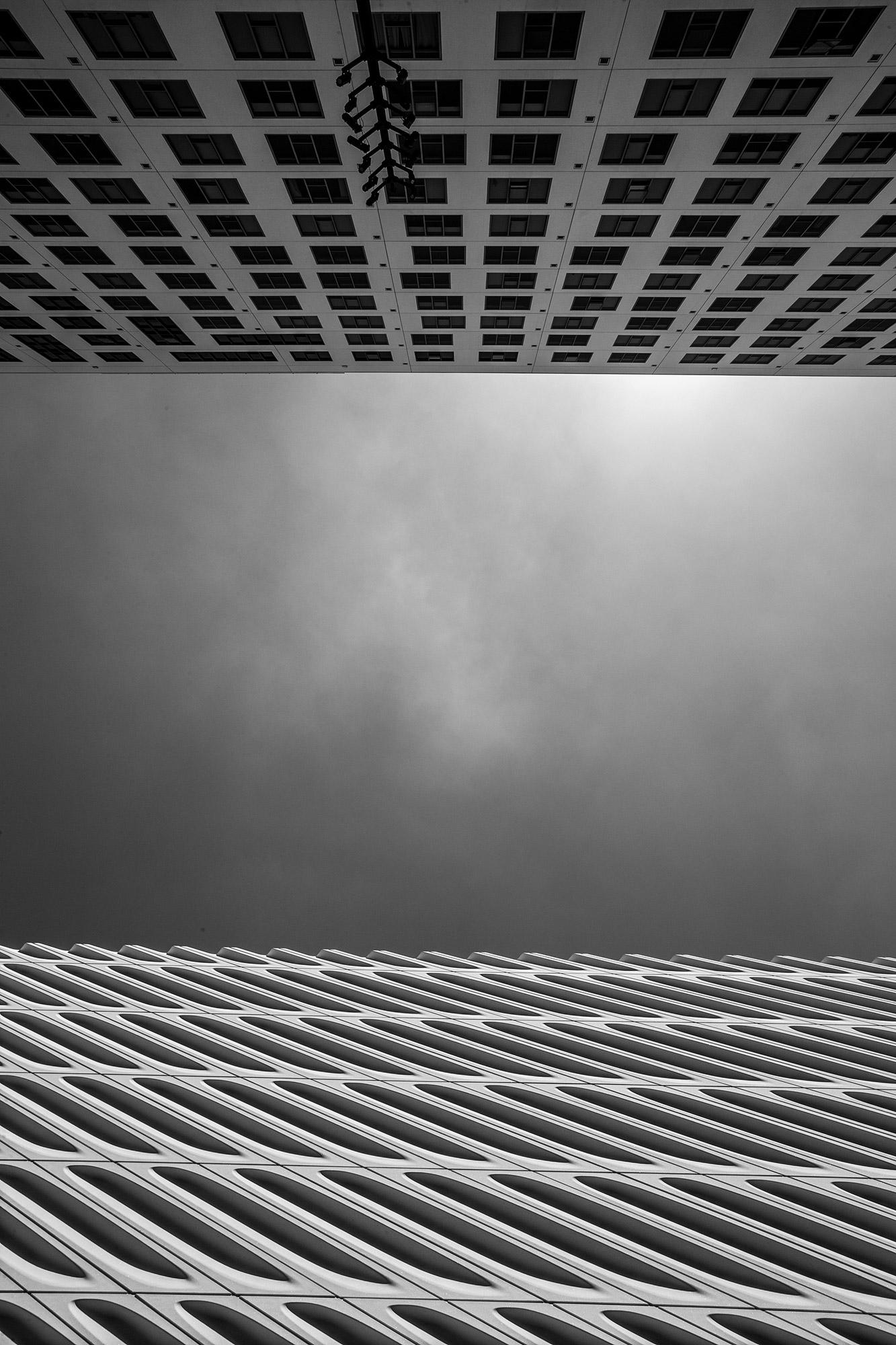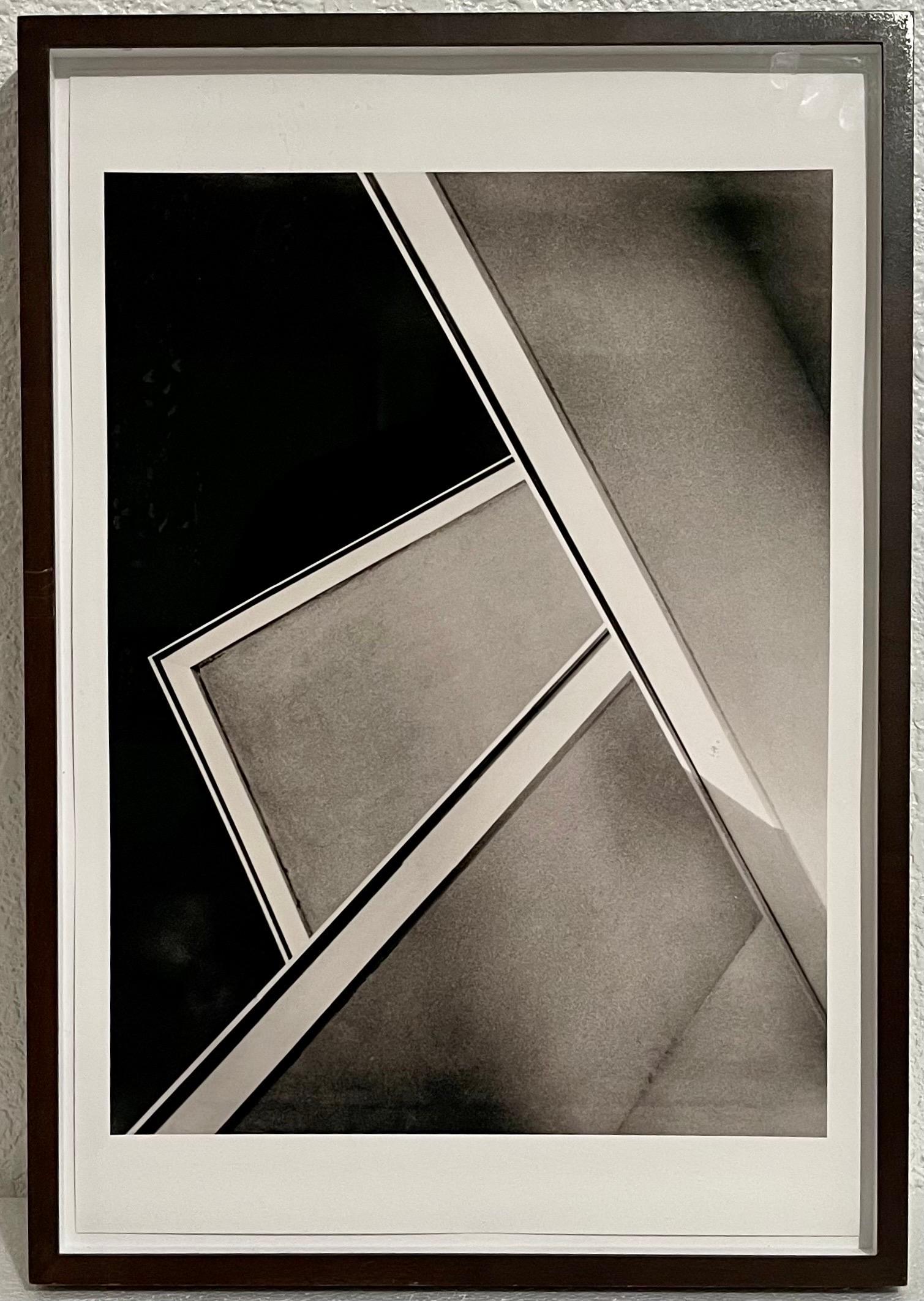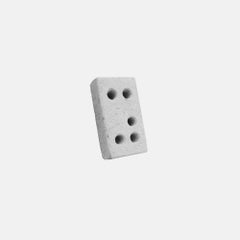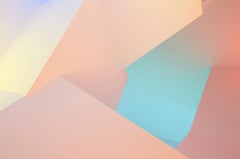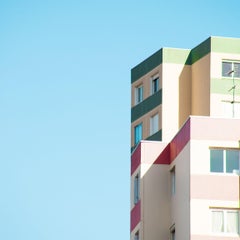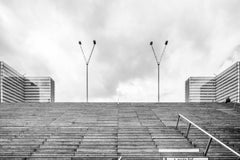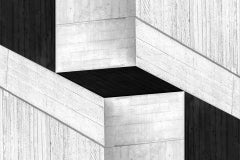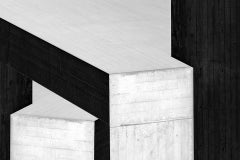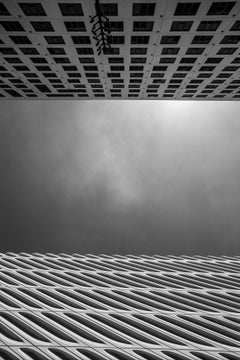Items Similar to Concrete Forms 03 by Bruno Fontana - Urban landscape photography, architecture
Video Loading
Want more images or videos?
Request additional images or videos from the seller
1 of 8
Bruno FontanaConcrete Forms 03 by Bruno Fontana - Urban landscape photography, architecture2019
2019
$6,180.86
£4,602.81
€5,200
CA$8,533.51
A$9,460.66
CHF 4,971.95
MX$115,782.96
NOK 62,094.55
SEK 58,281.94
DKK 39,591.07
About the Item
Concrete Forms 03 is a unique photograph by contemporary artist Bruno Fontana.
This photograph is sold framed (oak and glass museum frame, already included in the price) and signed.
The series name, "Concrete Forms," is a play on the homophone "concrete" in the English language. The phrase alludes to concrete, as in the building materials depicted in the images, such as a slab, a staircase, a block, etc. The word "concrete" also translates as "concrete," a reference to reality that the artist frequently questions. The photographic printing method of charcoal printing, which dates back to the end of the 19th century, is used by Bruno Fontana in "Concrete Forms."
Bruno Fontana investigates urban settings. He nudges the viewer to take a closer look at commonplace details, architectural components, and landscapes. Every photographic collection is a sincere invitation to observe with curiosity and to let go of preconceived notions, fantasies, and imaginations.
- Creator:Bruno Fontana (1975, French)
- Creation Year:2019
- Dimensions:Height: 25.6 in (65 cm)Width: 25.6 in (65 cm)
- Medium:
- Movement & Style:
- Period:
- Condition:
- Gallery Location:Paris, FR
- Reference Number:1stDibs: LU803113091192
About the Seller
5.0
Platinum Seller
Premium sellers with a 4.7+ rating and 24-hour response times
Established in 2013
1stDibs seller since 2017
516 sales on 1stDibs
Typical response time: 5 hours
- ShippingRetrieving quote...Shipping from: Paris, France
- Return Policy
Authenticity Guarantee
In the unlikely event there’s an issue with an item’s authenticity, contact us within 1 year for a full refund. DetailsMoney-Back Guarantee
If your item is not as described, is damaged in transit, or does not arrive, contact us within 7 days for a full refund. Details24-Hour Cancellation
You have a 24-hour grace period in which to reconsider your purchase, with no questions asked.Vetted Professional Sellers
Our world-class sellers must adhere to strict standards for service and quality, maintaining the integrity of our listings.Price-Match Guarantee
If you find that a seller listed the same item for a lower price elsewhere, we’ll match it.Trusted Global Delivery
Our best-in-class carrier network provides specialized shipping options worldwide, including custom delivery.More From This Seller
View AllConcrete Forms 01 by Bruno Fontana - Urban landscape photography, architecture
Located in Paris, FR
Concrete Forms 01 is a unique photograph by contemporary artist Bruno Fontana.
This photograph is sold framed (oak and glass museum frame, already included in the price) and signed...
Category
2010s Contemporary Black and White Photography
Materials
Charcoal
Untitled V by Matthieu Venot - Abstract photography, architecture, urban, city
By Matthieu Venot
Located in Paris, FR
Untitled V, Urban Nautilus series, is a limited-edition photograph by contemporary artist Matthieu Venot.
This photograph is sold unframed as a print only. It is available in 3 dime...
Category
2010s Contemporary Abstract Photography
Materials
Photographic Paper, Pigment
GL 06-23 by Riccardo Varini - Architecture photography, geometry, light, shapes
Located in Paris, FR
GL 06-23 is a limited-edition photograph by French contemporary artist Riccardo Varini.
This photograph is sold unframed as a print only. It is available in only one size:
*30 × 45...
Category
2010s Contemporary Landscape Photography
Materials
Photographic Paper, Inkjet
Untitled I by Matthieu Venot - Abstract photography, architecture, large-size
By Matthieu Venot
Located in Paris, FR
Untitled I, Ain’t Got No Troubles series, is a limited-edition photograph by contemporary artist Matthieu Venot.
This photograph is sold unframed as a print only. It is available in...
Category
2010s Contemporary Abstract Photography
Materials
Photographic Paper, Pigment
$2,282 Sale Price
20% Off
Free Shipping
GL 10-23 by Riccardo Varini - Architecture photography, geometry, vivid, shapes
Located in Paris, FR
GL 10-23 is a limited-edition photograph by French contemporary artist Riccardo Varini.
This photograph is sold unframed as a print only. It is available in only one size:
*45 × 30...
Category
2010s Contemporary Landscape Photography
Materials
Photographic Paper, Inkjet
GL 25-23 by Riccardo Varini - Architecture photography, geometry, light, shapes
Located in Paris, FR
GL 25-23 is a limited-edition photograph by French contemporary artist Riccardo Varini.
This photograph is sold unframed as a print only. It is available in only one size:
*45 × 30...
Category
2010s Contemporary Landscape Photography
Materials
Photographic Paper, Inkjet
You May Also Like
Italian Contemporary Photography by Luca Battaglia - Folding Cities #15
By Luca Battaglia
Located in Paris, IDF
Photographic Fine Art Paper 325 g, ed. 4/7
Luca Battaglia is an Italian architect and photographer born in 1970 who lives and works in Paris, France. Luca met the Italian photograph...
Category
2010s Contemporary Black and White Photography
Materials
Photographic Paper
Monochromatic #03, Black + White Contemporary Minimalist Art, Brutalist Art
By Cristian Stefanescu
Located in Deddington, GB
Cristian Stefanescu
Monochromatic #03
Black and White Abstract Geometry, Limited Edition Digital Photograph
Edition of 30
Artists Proofs 3
Ultra HD Photo Prints On Aluminium Dibond developed on matte Fuji Crystal Professional Archive Maxima photo paper. The matte surface prevents glare; surfaces are laminated with a UV protective film that makes them resistant to light.
Image Size: 60 cm x 90 cm x 2 cm
Sold Unframed
Arrive Ready to Hang (integrated wall-mounts on the back using aluminium rail rectangle)
Free Shipping
Please note that in situ images are purely an indication of how a piece may look.
Monochromatic #03 is part of a series of photographs entitled Monochromatic by Cristian Stefanescu. This black and white abstract geometry series is presenting a dialogue with the elements of perceptions and space. Seeing is unconscious using our senses, our intellect and our emotions in order to interpret the world around us according to our own personality, frame of reference or system of beliefs.
I like to use as starting point the elements already created in our reality, fragments of nature or made by human hand. I like to restructure the images I am taking, by altering the angles and relative lengths, joining structures or spatial symbols into a combined representation of matter, just as I like to reorganise my thoughts, in order to be able to change my interpretation, or better say my perception and while doing so I add new forms or perspectives to each thought.
Cristian Stefanescu, artist, is available for sale online and in our art gallery at Wychwood Art. Oxford based artist Cristian Stefanescu was born in 1968 in Bucharest. He obtained an MSc degree in 1992 at the Technical University of Construction Bucharest, specialisation in Water and Wastewater Treatment followed by the second MSc in 1994 obtained at University of Liège, specialisation in Groundwater Engineering. After having spent more than a decade of his life teaching at the Technical University of Construction Bucharest, Cristian moved from academia to photography working in fashion industry. The passion for photography developed in the early years of college and became a constant element of his life. After long and constant collaborations with fashion brands in Romania, in 2018 Stefanescu moved to London to open his own studio. Photography was born black and white and he chose to continue this tradition, while working on evolving the visual aesthetics of this raw art form rendering his believes. Cristian Stefanescu’s distinctive monochrome photographs are an exploration into the psychological and metaphysical. He captures nature or buildings in specific moments in time – through highly visual heartbreakingly dark images often overlapped with low-contrast minimal landscapes – to create works that stretch the idea of a hypothetical time. His photo installations exist in dialogue with the elements and perceptions of space and time. “Seeing is unconscious using our senses, our intellect and our emotions in order to interpret the world around us according to our own personality, frame of reference or system of beliefs.” he has said. “I like to use as starting point the elements already created in our reality, fragments of nature or made by human hand. I like to restructure the images I am taking, by altering the angles and relative lengths, joining structures or spatial symbols into a combined representation of matter, just as I like to reorganise my thoughts, in order to be able to change my interpretation, or better say my perception and while doing so I add new forms or perspectives to each thought. This is perhaps why I love photography, because it is simply a visual capture of something already created in the world and is always changing through our interpretation, it is more like a reflexion of our thoughts.” Always preferring to focus on the space rather than its subjects Stefanescu is obsessive about the contrast of his photography, in order to channel the intensity of light and texture of the storied buildings or nature elements. He documents concrete buildings, using the subject as representative for its physical referents, while considering metaphorically the world as the concrete representation of our emotions. Concrete thinking requires facts and representation about everyday life, palpable objects in a tree dimensional world. Stefanescu uses his photographs to deconstruct and alter reality in order to obtain abstract images, since by definition the abstract thinking involves a mental process and an abstract object does not exist in time or space, but rather exists as a thought, as an idea. “I use art in a reversed process of creation. I believe thought forms what our eyes can see, so I take what was already created by the thought of another and I try to place it back into what is known forever in the mind” he has said. Cristian Stefanescu believes in the energy of every being, of each object or nature element. He upholds that photography renders the ineffable combination of the object’s energy and the photographer’s one while taking a picture. And what is the energy of a photograph? Is it the energy of the space that is framed in the viewfinder, is it the energy of the photographer? I think it is an ineffable combination of the photographer’s energy when he pressed the shutter button and everything that forms the energy of the photographed space...
Category
21st Century and Contemporary Minimalist Black and White Photography
Materials
Metal
Monochromatic #02, Brutalist Art, Contemporary Black & White Statement Art
By Cristian Stefanescu
Located in Deddington, GB
Monochromatic #02 is part of a series of photographs entitled Monochromatic by Cristian Stefanescu. This black and white abstract geometry series is presenting a dialogue with the elements of perceptions and space. Seeing is unconscious using our senses, our intellect and our emotions in order to interpret the world around us according to our own personality, frame of reference or system of beliefs.
I like to use as starting point the elements already created in our reality, fragments of nature or made by human hand. I like to restructure the images I am taking, by altering the angles and relative lengths, joining structures or spatial symbols into a combined representation of matter, just as I like to reorganise my thoughts, in order to be able to change my interpretation, or better say my perception and while doing so I add new forms or perspectives to each thought.
Cristian Stefanescu, artist, is available for sale online and in our art gallery at Wychwood Art. Oxford based artist Cristian Stefanescu was born in 1968 in Bucharest. He obtained an MSc degree in 1992 at the Technical University of Construction Bucharest, specialisation in Water and Wastewater Treatment followed by the second MSc in 1994 obtained at University of Liège, specialisation in Groundwater Engineering. After having spent more than a decade of his life teaching at the Technical University of Construction Bucharest, Cristian moved from academia to photography working in fashion industry. The passion for photography developed in the early years of college and became a constant element of his life. After long and constant collaborations with fashion brands in Romania, in 2018 Stefanescu moved to London to open his own studio. Photography was born black and white and he chose to continue this tradition, while working on evolving the visual aesthetics of this raw art form rendering his believes. Cristian Stefanescu’s distinctive monochrome photographs are an exploration into the psychological and metaphysical. He captures nature or buildings in specific moments in time – through highly visual heartbreakingly dark images often overlapped with low-contrast minimal landscapes – to create works that stretch the idea of a hypothetical time. His photo installations exist in dialogue with the elements and perceptions of space and time. “Seeing is unconscious using our senses, our intellect and our emotions in order to interpret the world around us according to our own personality, frame of reference or system of beliefs.” he has said. “I like to use as starting point the elements already created in our reality, fragments of nature or made by human hand. I like to restructure the images I am taking, by altering the angles and relative lengths, joining structures or spatial symbols into a combined representation of matter, just as I like to reorganise my thoughts, in order to be able to change my interpretation, or better say my perception and while doing so I add new forms or perspectives to each thought. This is perhaps why I love photography, because it is simply a visual capture of something already created in the world and is always changing through our interpretation, it is more like a reflexion of our thoughts.” Always preferring to focus on the space rather than its subjects Stefanescu is obsessive about the contrast of his photography, in order to channel the intensity of light and texture of the storied buildings or nature elements. He documents concrete buildings, using the subject as representative for its physical referents, while considering metaphorically the world as the concrete representation of our emotions. Concrete thinking requires facts and representation about everyday life, palpable objects in a tree dimensional world. Stefanescu uses his photographs to deconstruct and alter reality in order to obtain abstract images, since by definition the abstract thinking involves a mental process and an abstract object does not exist in time or space, but rather exists as a thought, as an idea. “I use art in a reversed process of creation. I believe thought forms what our eyes can see, so I take what was already created by the thought of another and I try to place it back into what is known forever in the mind” he has said. Cristian Stefanescu believes in the energy of every being, of each object or nature element. He upholds that photography renders the ineffable combination of the object’s energy and the photographer’s one while taking a picture. And what is the energy of a photograph? Is it the energy of the space that is framed in the viewfinder, is it the energy of the photographer? I think it is an ineffable combination of the photographer’s energy when he pressed the shutter button and everything that forms the energy of the photographed space...
Category
21st Century and Contemporary Contemporary Abstract Prints
Materials
Metal
Versus. Architectural Landscape black and white limited edition photograph
By Juan Pablo Castro
Located in Miami Beach, FL
Frames that capture the transformation from everyday life into another reality. Images that explore how the future will look. The proposal comes from the contemporary but goes beyond...
Category
2010s Contemporary Black and White Photography
Materials
Photographic Paper, Black and White, Archival Pigment
Brazilian Conceptual Modernist Photograph Jose Yalenti Architectural Abstract
Located in Surfside, FL
José Yalenti, (1895-1967) Brazilian Photographer
"Beiras" (Sides)
Photo, numbered 5/15, circa 1950, (printed later) on premium luster photo paper with ultrachrome ink.
Art: 15" H x 11" W; Frame: 20 1/4" H x 14 1/4" W.
Provenance: Dickinson Roundell Gallery
José Yalenti’s Architecture photos seem at first disorienting, abstract black & white and grey surfaces, cut through by startlingly straight lines and a variety of surface textures. Much of his work is of mid-century Latin American architecture, by the likes of Oscar Niemeyer and Roberto Burle Marx.
José Yalenti was born in São Paulo, Brazil in 1895. On April 28, 1939, a group of photography aficionados, including Yalenti, formed the Foto Clube Bandeirante, later changed to Foto Cine Clube Bandeirante, or FCCB.
Starting in the late 1940s, a contingent of FCCB photographers began creating photographs of abstracted architectural motifs (as in Architecture or Twilight), and eventually became known as the Escola Paulista, or “Paulista School.” Yalenti was among the members of the unofficial Paulista School. Between 1945 and 1960, the Paulista School photographers explored the rapidly changing formal qualities of São Paulo. By photographing skyscrapers and stairways at steep angles, creating closely cropped compositions from found geometric motifs, and capturing the flattening effects of shadows, Paulista School photographers investigated the new physical perspectives emerging in the urban environment. They created a distinctively Modern aesthetic that used strong contrasts of light and dark, geometric forms, linear compositions, and collapsed space to assert photography’s status as an artistic medium.
As part of their pursuit of photographic Modernism, Yalenti and his fellow Brazilians adapted the stylistic innovations of U.S. and European photographers such as f.64, New Objectivity, Dada, Surrealism, and the Bauhaus, to the Brazilian context. Along with his FCCB compatriots—Thomaz Farkas, Geraldo de Barros, and German Lorca, among others—Yalenti explored the formal properties of black-and-white image-making.
Yalenti and the Paulista’s School’s abstract photographs responded to the new trends in Brazilian Modernist architecture being developed by young architects in São Paulo and Rio de Janeiro. In 1939, Lúcio Costa, Oscar Niemeyer, and Affonso Reidy broke ground on the Ministry of Education and Health Building (MES), the building that would define Brazilian architectural modernism. The Rio-based team combined elements of Le Corbusier’s undecorated structural purity with Brazilian regional design to produce a more organic and “tropical” Modernism that responded to the local culture and climate.
The sinuous and sensuous curves of Yalenti’s photograph are directly influenced by stylistic developments in architecture at the MES, including the building’s covered entry and its organically abstract contours. By 1957, when Yalenti created Architecture or Twilight, Brazil was globally recognized as an architectural leader. MoMA in New York City organized a popular exhibition of Brazilian architecture in 1943 (“Brazil Builds”), and highlighted the country again in its survey show "Latin American Architecture since 1945," that ran from 1955–56. Brazilian photography...
Category
20th Century Modern Black and White Photography
Materials
Photographic Paper
Concrete - large scale photo of tonal palette texture of Brutalist architecture
By Frank Schott
Located in San Francisco, CA
Concrete (2014) by Frank Schott, a study of monochromatic details of contemporary urban architecture, urban textures and tonal color palettes
27 x 40 inches / 68cm x 102cm
signed ed...
Category
21st Century and Contemporary Contemporary Black and White Photography
Materials
Archival Ink, Archival Paper, Photographic Paper, Archival Pigment
More Ways To Browse
Architectural Staircase
Sophie Vintage
Gelatin Print Audrey Hepburn
Palladium Print Nudes
David Bull
Vintage Wedding Photo
Antique Photography Studio
Jacqueline Kennedy Onassis
Photograph Frank Sinatra
Terry Paris
David Hamilton
Emmy Award
Silver Piano
Gay Photography
Dinner Photography
Louis Armstrong
Zebra Art Prints
Elvis Photos
